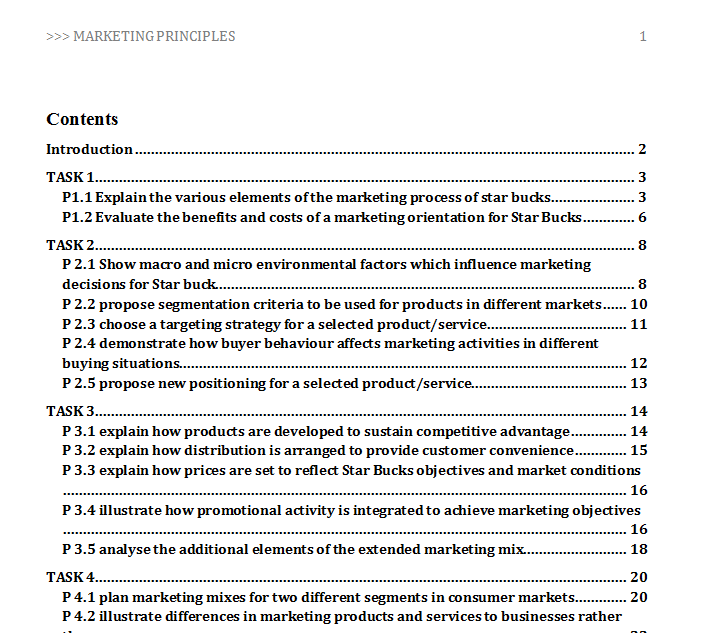- support@locusassignments.com
Unit 4 Marketing Principles Sample Assignment

Introduction
Marketing can be defined as a process where producer of goods or services communicates with value of the product or services to the prospective customers. This communication is essential, since entire selling of the product is based on how effective is the process of marketing (Kotler & Armstrong, 2013). Based on the case study of Starbucks this case study will analyse the entire concept of marketing, the process involved in it, and various other aspects which are necessary to understand the importance marketing.
TASK 1
P1.1 Explain the various elements of the marketing process of star bucks
For a business organisation to succeed in its marketing, preparation of a strategic marketing plan is extremely important. Entire process of marketing planning process has been displayed below, and consists of following stages:
- Goal Setting
- Corporate Objective
- Analysis of Current situation
- Marketing Audit
- SWOT Analysis
- Marketing Assumptions
- Creation of marketing strategy
- Marketing objectives and strategies
- Forecast of expected results
- Creation of alternative plans
- Allocation of marketing resources and monitoring
- Marketing budget
- Detailed Action Plan

Figure 1: Marketing Planning Process
Two elements of marketing process w.r.t to Starbucks is as follows:
Goal Setting: This phase of marketing process identifies the core mission with Starbucks has established its business. Mission of Starbucks is “to inspire and nurture the human spirit – one person, one cup, and one neighbourhood at a time.”This clearly indicates that how Starbucks has focused on creating a market for coffee which is not only of high quality but is also affordable by people.
Analysis of Current Situation: Market Audit: This phase of marketing process focuses on analysis of the market condition and how a business can establish itself. In this regard Starbucks international expansion strategy can be considered. As a result of market audit Starbucks was able to understand that in order to expand in different geographies it is essential to hire multi lingual and multinational managers who can help the company in its worldwide expansion.
One important component of marketing planning process is SWOT analysis. SWOT analysis is a useful tools for marketers who can utilise it to understand the environment in which a business functions (Friesner, 2011). It is an important tool because it helps the organisation to identify the differentiating factor a product has against the competitor. Other benefits of SWOT analysis are:
- It helps in better understanding of the business
- SWOT analysis helps in addressing the weakness of the organisation
- It helps effective development of business strategy and goal to achieve them
SWOT analysis of Starbucks is as follows:
|
Strength
|
Weakness
|
|
Opportunity
|
Threat
|
P1.2 Evaluate the benefits and costs of a marketing orientation for Star Bucks
Market orientation approach defines the approach with which an organisation like Starbucks reacts to customer requirements (Narver& Slater, 1990).Thus decision which are taken are based purely on the basis of what customer need, rather than what business assumes or think about the customer. Starbuck’s growth and success to a great extent can be attributed to its market oriented approach.
Since its inception in 1971, Starbucks has evolved as an “anyone can drink coffee’ brand. Starbucks based on its marketing orientation has got following benefits:
- Opened more than 50 outlets in developing countries such as India within span of one year.
- Gained more than 65% of coffee based beverage market share since 2005 onwards till 2012.
- Year-on-year growth of 5% despite of gradually saturating market.
- Rapidly growing brand awareness about Starbucks especially in countries where recently it has started its operations. For example within 6 months of its operation in India, Starbucks got a customer base of more than 75,000.
- Marketing oriented approach has also helped Starbucks in achieving 30% return customer for consecutively 5 years since 2006.
- In a country like Sri Lanka, it became a Super brand within 5-7 years of operations.
- Market orientation has also resulted into enhanced customer experience. For example based on a survey conducted in United States in 2012, more than 80% of the teenagers mentioned Starbucks as their first preference as compared to any other coffee brand.
- Based on the sustained efforts in getting customer feedback, Starbucks has been regularly launching variety of coffee based beverages to cater to different categories of customer. This can be understood by the fact that Starbucks offer more than 14 types of coffees and 4 decafs in their stores across globe.
In general market orientation has helped Starbucks in establishing its brand in countries where it is trying to expand its presence (Miles & Arnold, 2001). In terms of cost Starbucks spent more than 15% of its revenue on marketing budget in year 2012 in Asia region. This reflects the fact that how Starbucks has been aggressively focusing on expansion in growing countries. Based on its marketing orientation Starbucks is expecting to see a growth of 4.5 % from 2013 to 2014 based on its concentrated customer centric approach.
For complete solution of this unit, order now from Assignment Help
Need Help with Your Assignment?
Get expert guidance from top professionals & submit your work with confidence.
Fast • Reliable • Expert Support
Upload NowDetails
Other Assignments
Related Solution
Other Solution


